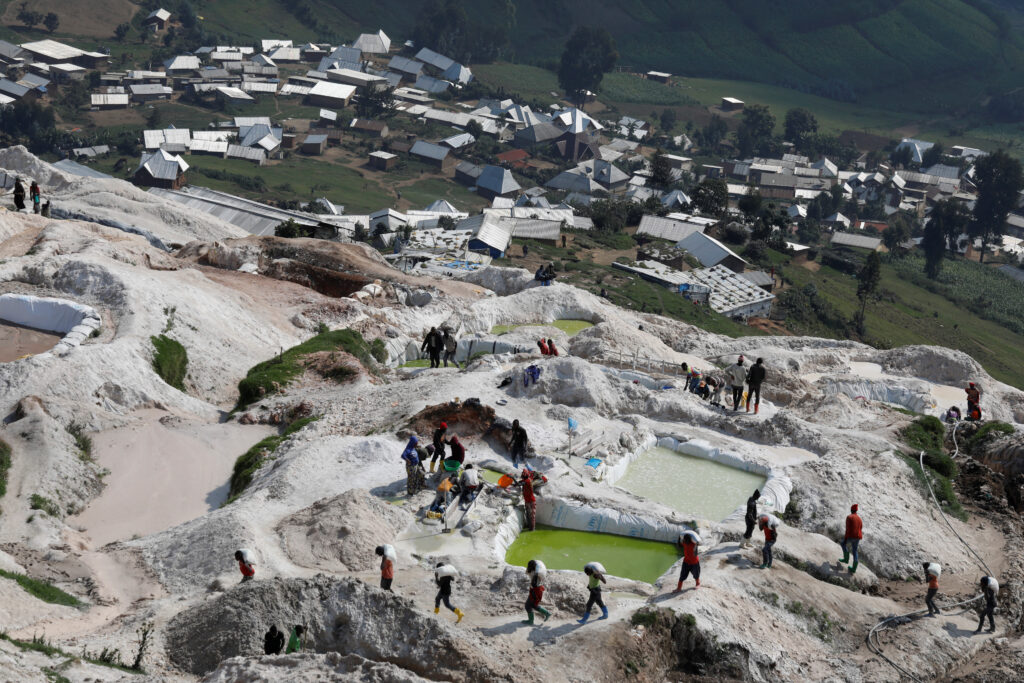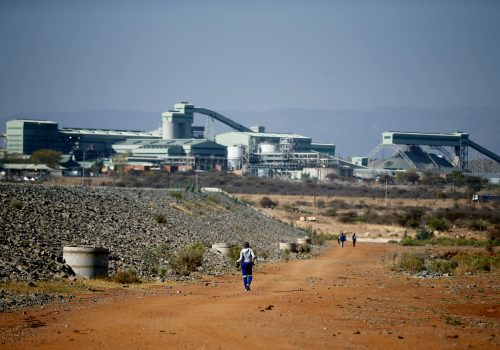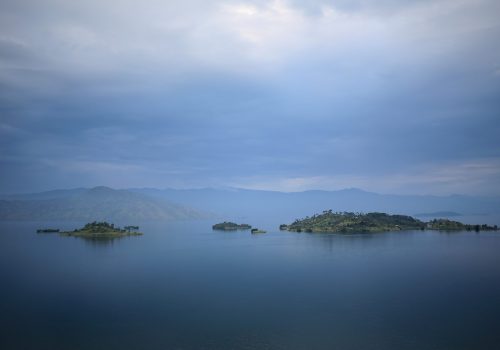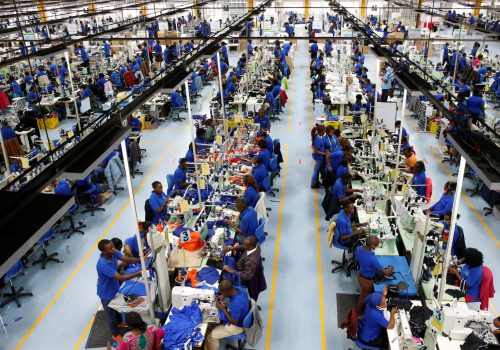Technology is increasingly influencing the way people around the world live, creating opportunities in some cases and introducing new challenges in others.
Just as important as a technology’s impact is the technology’s origin—or origins. Any given technology can be traced back, through its individual components and materials, to a number of sources. And the question about where those components and materials come from matters. Modern technology, economies, livelihoods, and weapons depend on critical minerals such as magnesium, cobalt, lithium, or even copper. Where countries source these minerals makes a difference for national and strategic security.
Since Africa is home to 30 percent of the world’s known critical minerals, the continent is at the forefront of conversations. But currently, African nations aren’t getting their fair share of the benefits of the critical-minerals boom and buzz generated by the evolution of modern technologies. For that to happen, Africa will need more investment in its capacities to refine or add value to minerals within the continent; such investment could fuel a long-awaited boost in development.
Africa is home to many critical-mineral reserves, but it is not home to industry that adds value to the minerals, such as the processing and refining of them. While Africa does have some processing and refining capacity for certain minerals, substantial value-additive steps across the sector remain absent. To be blunt, Africa will only reap the benefits from the critical-minerals boom associated with mineral extraction. Concrete action toward the goal of the development of long-awaited value chain enhancement and investment in the continent remains elusive.
The African Union (AU) and various African nations have long been aware of the continent’s need (and right) to benefit from its mineral wealth, instead of supplying the minerals to the rest of the world for others to process and then reap economic benefits. In 2009, the AU released its African Mining Vision, highlighting the importance of value-adding industry. In 2019, the AU released the African Commodities Strategy, calling for the transformation of Africa from a continent that is merely a raw materials supplier to a continent that is integrated into global value chains. The AU created a African Minerals Development Centre to coordinate and oversee the implementation of the African Mining Vision. But since it was created in 2016, the center hasn’t been ratified by enough member states, meaning that it hasn’t been fully put into operation.
At this year’s Mining Indaba—for which heads of state, ministers, and thousands of mining-industry leaders and experts descended upon Cape Town, South Africa to chart a new future for African mining—it was clear that several topics are slated to dominate the critical-mining space on the continent in the years to come. Among the conference’s participants were members of the Atlantic Council’s Africa Center, who were there as part of a newly launched task force on critical minerals. Here are a few insights into the topics that will dominate Africa’s critical mining space in the near future and what the Africa Center will be focusing on in the sector over the next three years.
Minerals matter—for now
As the ever-growing importance of critical minerals continues to influence geopolitical gamesmanship, so too does a growing desire to find alternatives to the current supply chains in order to alleviate overreliance. Resources are being poured into initiatives that could lessen dependence on the extraction of critical minerals.
Take battery recycling for example. The global lithium-ion battery recycling market alone was valued at $6.5 billion in 2022 and is projected to reach $35 billion by 2031. On the public investment side, the United States has deployed funding and regulatory incentives for the recycling of batteries. The European Union (EU) adopted a regulation that sets target percentages for the recovery of critical minerals from batteries. Part of the regulation includes the introduction of a new “battery passport,” a digital record that accompanies each battery and includes information about its history and components to ensure it is recycled responsibly. Beyond efforts to increase battery recycling, there are also initiatives underway to develop batteries that are not reliant on rare-earth elements.
Private investment in research about battery replacement and alternative materials is rising—and with it, so too rises the likelihood that the economic benefits from today’s critical-minerals boom will bypass Africa. Today, the world needs what Africa has, but that may not be the case tomorrow.
US presence and prose
This year’s Mining Indaba was notable for the large delegation sent by the United States, which included high-level government officials such as Amos Hochstein, Jose Fernandez, British Robinson, and Reta Jo Lewis. That delegation is a clear demonstration of Washington’s level of interest regarding Africa’s critical minerals sector.
Perhaps the cornerstone of public US investment in Africa’s mining sector today is the Lobito Corridor project, which is looking to lay over a thousand miles of railroad to help transport critical minerals from Zambia and the Democratic Republic of the Congo to a port in Angola. The United States has emphasized that its interest in the project is not just about mineral extraction. As Hochstein highlighted at Mining Indaba, a train runs both ways. For the United States, publicly highlighting associated energy and livelihood projects is a way to show that the country is in Africa to do more than just national resource extraction.
Following Mining Indaba, US delegates made the trip from South Africa to Zambia for the Partnership for Global Infrastructure and Investment (PGI) Lobito Corridor Private Sector Investor Forum. The forum sought to gather up private-sector investment for the Lobito Corridor. At the forum, the US International Development Finance Corporation announced a new $250 million debt facility to the Africa Finance Corporation to support infrastructure across the continent. Other attendees—from the public and private sectors—rolled out projects for and investments in building energy power plants and storage facilities, and struck various mining and refining deals, including one that will seek to build the continent’s first refinery for electric-battery-grade cobalt sulphate.
While these are promising developments, most of the investment in the corridor is from the public sector: The United States, in partnership with the EU, has joined with the African Development Bank and the Africa Finance Corporation to inject over one billion dollars into the project. While the EU and United States are involved, private sector involvement is crucial for economic success. Just because Washington wants something doesn’t mean that it’ll happen; plus, what the US government wants and what private sector companies do does not always align. For example, while the US was relatively inactive in the minerals sector in Africa, China purchased cobalt mines in the Democratic Republic of the Congo from sources including a US-based mining company. The private sector, and the money and operations it chooses to conduct, will steer the success of projects such as the Lobito Corridor.
At Indaba, Hochstein stressed that there is no expectation from the US side for African nations to side exclusively with any country. The Biden administration has gone to great lengths to deemphasize great-power competition in its strategy toward Africa. This aligns with the US Strategy toward Sub-Saharan Africa, which the White House released in 2022. Yet, some experts view US and EU investment in the Lobito Corridor as an effort to counter China, amid concerns about Beijing’s dominant position over the African critical-minerals market.
Ideally, investment in Africa’s critical-mineral sector would support the continent’s capacity to add value to minerals before shipping. But efforts are needed beyond the Lobito Corridor which is, after all, intended to help transport—and eventually export—critical minerals. The underlying impetus of this project is the minerals; so if the demand for minerals falls, investment may begin to wane too.
The connection between Africa’s natural mineral wealth and the continent’s strategic importance for the United States is hardly new. The United States has sought out Africa’s critical minerals, for example for its geopolitical objectives, in the past: Infamously, the uranium used in the atomic bombs dropped in Hiroshima and Nagasaki was sourced from the Shinkolobwe mine in the Congo.
What the Africa Center is doing
The critical minerals discussion on extraction, national security, and supply chains will move past Africa unless the moment is seized.
The Africa Center’s task force will aim to unite stakeholders from the United States, Europe, and Africa, including representatives from the financial sector, development institutions, and government. Together, this group will regularly convene to explore the role and potential of African minerals in critical supply chains, strategies for greater inclusion of African nations and suppliers, and ways to mobilize the private sector. The task force will host public conversations on topics ranging from the need for private investment (and how to best facilitate it) to domestic African policymaking. The task force hopes to contribute to the building of a new business and development model through strategic and win-win partnerships.
If Africa is to truly benefit from the critical-minerals boom and buzz, then it will need support in developing its ability to add value to its minerals on the continent. Unless African nations can break from a history of serving only as a minerals supplier, they will be left behind.
Alexander Tripp is the assistant director for the Atlantic Council’s Africa Center.
Further reading
Thu, Oct 12, 2023
How the US can build better strategic partnerships in Africa to secure critical minerals
New Atlanticist By Nii Simmonds, Shirley Martey Hargis
The United States and other Western countries should incentivize their multinationals to offer African countries the same level of partnership that fostered Southeast Asian countries’ ventures into consumer electronics in the 1970s.
Tue, Dec 5, 2023
How green banking can unlock climate solutions in Africa
Report By Jean-Paul Mvogo
In order to succeed in its transition to a green and inclusive economy, Africa must ramp up its green banking ecosystems and mobilize resources needed to finance climate mitigation and adaptation while also addressing deforestation, pollution and biodiversity loss.
Thu, Oct 26, 2023
AGOA and the future of US-Africa Trade
Report By Frannie Léautier
Frannie Léautier launches her new report "AGOA and the future of US-Africa trade." AGOA serves as a key tool for both the United States and Africa as they look for ways to redefine and build their relationships.
Image: Labourers carry sacks of ore at the SMB coltan mine near the town of Rubaya in the Eastern Democratic Republic of Congo, August 13, 2019. Picture taken August 13, 2019. REUTERS/Baz Ratner



